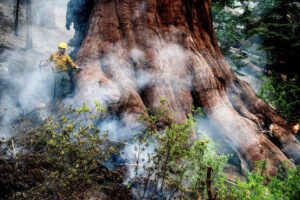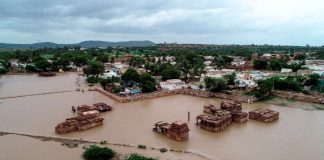JULY 23, 2022

The U.S. Forest Service has unveiled an emergency plan to try to save giant sequoias from the threat of wildfires.
The agency said Friday it won’t wait for the completion of environmental-review procedures before it begins clearing underbrush around the world’s largest trees. Such thinning projects help eliminate the fuel that wildfires consume as they grow.
The projects could begin this summer, the Forest Service said, rather than having to wait years under the regular approval process.
“Without urgent action, wildfires could eliminate countless more iconic giant sequoias,” Forest Service Chief Randy Moore said. “This emergency action to reduce fuels before a wildfire occurs will protect unburned giant sequoia groves from the risks of high-severity wildfires.”
The announcement came as firefighters are battling a wildfire in the Sierra National Forest that had spilled onto private land and forced evacuations of businesses and residences near Midpines, a community of about 300 people in Mariposa County, Calif.
The blaze began Friday around 2 p.m. PT, said Daniel Patterson, public information officer for the Sierra National Forest. It has burned about 6,500 acres with zero containment as of Saturday, he said.
Of the 37 giant sequoia groves on 37,000 acres of national forests in California, all but five have burned or partially burned in recent wildfires, according to the Forest Service. Many giant monarchs—the largest sequoias in a grove—were killed.
Since 2015, wildfires have caused significant destruction of the giant sequoia groves, which grow only in California’s Sierra Nevada range. Wildfires have destroyed nearly one-fifth of all giant sequoias in the last two years, the agency said.
The Forest Service emergency action plan will cover roughly 13,300 acres and protect 12 giant sequoia groves. It calls for the removal of what are known as surface and ladder fuels, a category that includes grasses, logs, stumps and standing dead trees with limbs close to the ground.
The emergency actions also include more prescribed burns, a forestry management tool that uses an intentionally set and controlled fire to clear underbrush and thin out overcrowded trees.
The Forest Service’s plan calls for a prescribed burn of nearly 12,000 acres in the Sequoia National Forest, the agency said, at a cost of about $15 million.
Work on eight groves could be initiated this summer and work on three additional groves could begin this fall.
In the Sierra National Forest, $6 million has been earmarked for a prescribed burn of roughly 1,400 acres and other projects, according to the agency. Work could begin this summer on three groves.
In May, Mr. Moore ordered a 90-day halt on prescribed burns after one in New Mexico unintentionally exploded into the largest wildfire in state history, due to unexpectedly strong and erratic winds.
Nonetheless, prescribed burns are a key tool to preventing wildfires and controlling the spread when they do happen, according to the Forest Service and other forestry researchers.
A California wildfire that erupted earlier this month near Yosemite National Park’s famous Mariposa Grove of about 500 sequoias didn’t reach the trees thanks to a protective ring burned around them in recent years by park crews.
The Washburn Fire, which started July 7, might even have done some good, according to Garrett Dickman, Yosemite’s forest ecologist. It burned a section of overgrown forest near the Mariposa Grove that had been earmarked for prescribed fire, he said.
As of Saturday the Washburn fire had burned just under 5,000 acres and was 79% contained, officials said.










































































































